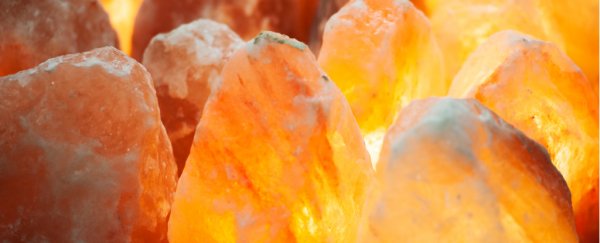There's no doubt that Himalayan salt lamps cast some seriously beautiful light, but can basking in their soft glow really improve your mental health?
Some people think it can. They claim that these lamps emanate negative ions which boost your serotonin levels, improving mood, alertness, anxiety, and even depression.
It seems like a hippy, far-fetched gimmick, but you might be surprised to know there's more to the story. In fact, there are hundreds of scientific papers looking into this very concept, some of them going back a full century.
A new video from Derek Muller at Veritasium takes us to the bottom of the mystery, starting with a salt lamp.
The idea behind negative ion therapy is pretty basic: positive ions in the air make us feel bad, and negative ions in the air make us feel good.
Now, half of that idea is true. There are negative ions in the air. Some are made by cosmic rays, slamming into the atmosphere and spreading their energy into atoms or molecules that were just minding their own business.
Others are made by natural radioactivity, emanating from the earth, or lightning bolts, spewing ions from the sky. Even waterfalls and waves contribute their share.
You might be thinking: maybe that's why I feel good near the beach, or after a thunderstorm. You wouldn't be the first to think that; scientists have been looking into these questions for nearly a hundred years.
In one study, researchers treated patients who had seasonal affective disorder (SAD) with different concentrations of negative ions to see whether any of them worked better than bright-light therapy.
Just like bright-light therapy, a high concentration of negative ions were able to reduce some of the patient's depressive effects.
In another study, those in a high-ion environment showed faster reaction times and reported being more energetic.
Even when the negatives are traded for positives, the idea can hold up. When exposed to high concentrations of positive ions for two hours, participants in one study reported increased anxiety.
But does any of this apply to salt lamps? In the video above, when Derek takes the negative ions to be measured, even experts at Caltech can't find any negative ions emanating from the lamp.
The problem is, that's kind of what those lamps are sold for - water molecules are supposed to land on the surface of the lamps, liberating negative chloride ions from the lattice. But from a physics perspective, that would require way too much energy - far more than a simple salt lamp could muster.
Sure, there are other crystals and tools up to the task, but as Derek finds out, those can be really expensive both on your bank account and your body.
In the end, he decides the research is just too inconsistent. While there have been studies to suggest positive effects from negative ions, there are plenty of other studies that have showed inconclusive results or no significant differences at all.
Besides, even the studies that did find something beneficial had their issues, especially with their methods and sample sizes.
"So, I think ultimately," explains Derek, "if you are looking for a way to improve your mental and physical health that is backed by strong scientific evidence, then you should take a walk outside."
